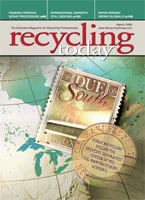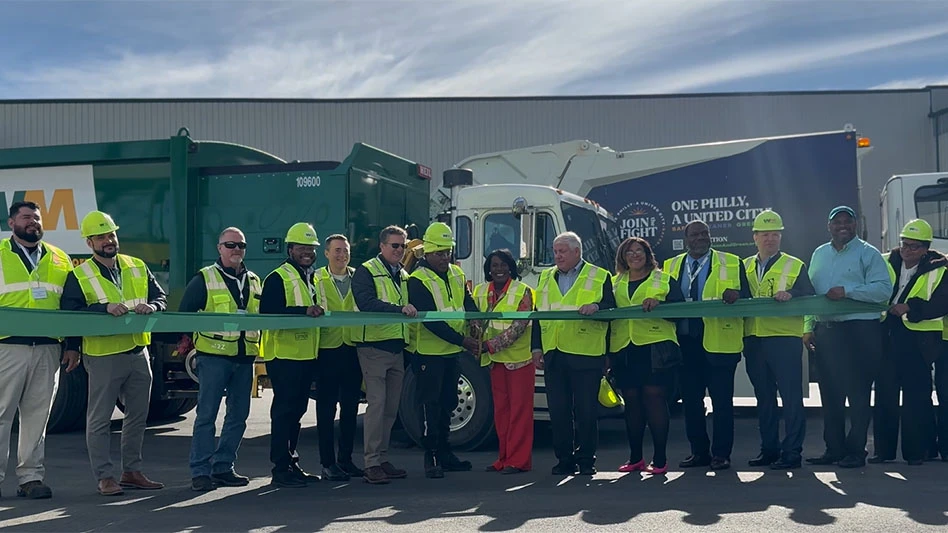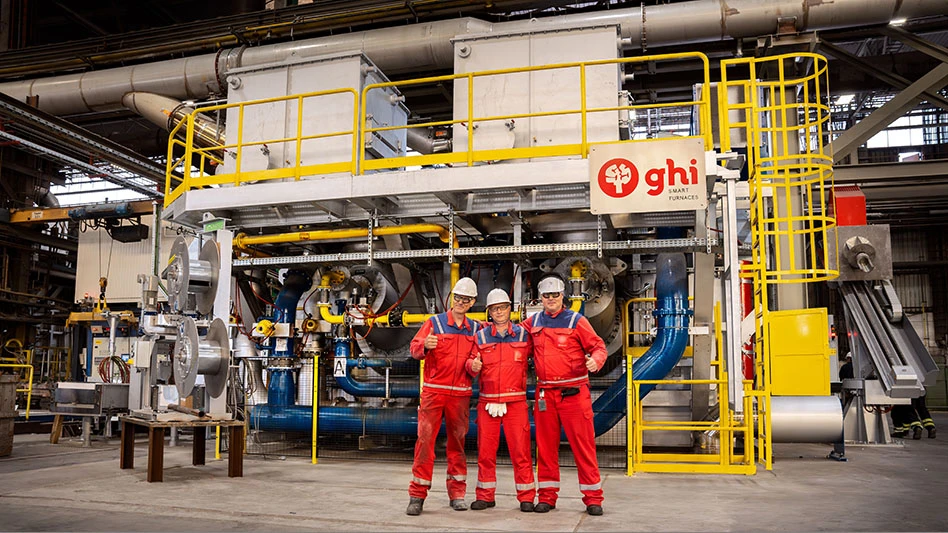 Nathan Frankel |
By the late 1990s, the ferrous scrap world had a pretty good grip on arranging rail and truck shipments within the United States. Seaborne scrap, though, remained the domain of bulk brokers.
Nathan Frankel, president of Advanced Steel Recovery (ASR), Rancho Cucamonga, Calif., is taking steps that could change that. In the process, he is taking control of his own professional life.
Ironically, the self-described "hybrid geek" did not set out to change the scrap world. He always had it in the back of his mind that he would work with his father Leo in the business. But he pursued other interests, like classical violin (he currently serves on the advisory board of Young Artists International, a non-profit organization that assists promising young musicians around the globe). He attended school in the East at Boston’s Brandeis University. At that time, the Internet was growing, and Nathan saw potential there that he would realize later.
Returning to the West, he got involved in recycling as a consultant and broker. Quickly, he says he realized this age-old industry begged for an overhaul. Technology, service, value and integrity were among the fundamental areas that seemed ripe for bolstering within the scrap metal industry, according to Nathan.
While the company’s Web-based Metal Management System is important to customers who want access to records, Nathan’s biggest coup was in the world of scrap transportation. He developed the FASTek system for loading bulk containers for overseas shipments, enabling ASR and its customers to profit from overseas markets.
HANGING TOUGH. "When we first got into business, the market was not healthy," Nathan says, noting prices as low as $50 per ton. "But as the cycle changed, there was demand from overseas," he adds.
While the demand was enticing, there was a large disconnect between the break-bulk brokers that most yards had to deal with and their eventual customers.
ASR focused on domestic mills, but the lure of overseas business was strong. "Demand seemed unlimited. There was a significant premium to the local market," Nathan says.
The problem at ASR, as at most other yards, was the time it took to load an export container, although in theory such containers could allow ASR to bypass the break-bulk market. Two to four hours was a normal loading time, and often the container would be damaged in the process.
"There was not enough time in a day nor space for a loader facility," Nathan says. Still, he was convinced of the viability of sea containers for shipping ferrous scrap—if only they could be loaded efficiently.
That’s when Nathan developed his idea for the FASTek system. He hired a lawyer to look at patents and a New Mexico engineering firm to create a prototype. A project that was supposed to cost $300,000 and take three months dragged out beyond a year. Associates, even friends, began to compare his project to billionaire Howard Hughes’s Spruce Goose airplane—an expensive investment in technology that would never fly.
But Nathan did not give up. Eighteen months and more than $1 million later he took delivery of the FASTek prototype. The company began testing the unit in February of 2005.
"It will load a container in six minutes without damaging the container," Nathan says of the FASTek, which features an integrated scale. Add the 10 minutes it takes to load on the yard, and the FASTek will fill a container in about 15 minutes.
"Nobody believed we could fill a 100-container booking in five days," he says. Yet it worked. ASR can do 800 tons per day with a two-man team, enabling ASR, which is 60 miles from the ocean, to become an exporter. "It can be replicated anywhere: Los Angeles, Omaha, Kansas City," Nathan says.
ASR quickly added a second machine. "We currently have two FASTek machines, allowing us to ship out approximately 800 tons per eight-hour shift in containers," he continues. That is about 40 containers per day.
"It is not bragging to say this is unparalleled in the world," he says.
In theory, with six machines, ASR can equal the capacity of any break-bulk company without the $300,000 monthly port lease payment. FASTek also takes up little physical space in the yard.
In 15 minutes, with just one operator, FASTek loads 21 metric tons into a 40-foot sea container, compared to up to four hours and four men it used to take, according to Nathan. "Plus, FASTek eliminates the use of traditional backhoe steel loaders," he says.
"On top of that, there are fuel savings, logistics savings—we don’t have to send a truck back empty. There are no more deadhead hauls."
Best of all, ASR gets to use the difference between the overseas market and local spot pricing to compete with the larger scrap operators at the port. By offering its customers stronger pricing, ASR has helped the southern California scrap market remain fair, Nathan contends. "I’m selling overseas to a guy who is paying exactly what he would to a break-bulk dealer," Nathan says.
ON THE WEB. Tracking the added tonnage might seem like a giant task, but Nathan has attacked that with vigor, too. He has made ASR a Web-savvy company. Its Web site, www.advancedsteel.com, offers customers a chance to follow their own accounts.
Nathan says he saw a crying need for "transparency" in the scrap business. "We wanted a system that would give our clients ability to see what they are doing 24/7," he says.
"Integrity is key," Nathan continues. "We have had tremendous success in [enhancing] the reputation of the industry and will continue to make that our No. 1 priority," he says.
His answer to this potential problem is ASR’s Web-based portal called "Metal Management System (MMS)." It allows ASR’s customers to analyze their current scrap metal output and compare it to past production. This lets customers keep tabs on what is happening in their own businesses as well as letting them accurately project scrap metal output.
"Our Web engineers designed MMS to be user-friendly and secure," says Nathan. "Through a password protected, user-defined login, clients are only a few keystrokes away from total access to their scrap metal production online 24/7."
Designed to be simple to set up and to navigate, MMS answers questions like: How much scrap did a company produce? Where did its past scrap output go? What did it weigh? What was the company paid for a shipment?
"We let people tap into our system and see how much scrap we pull out each day, week, month or quarter and what they were paid for it," Nathan says. "It does not eliminate the possibility to steal. But things either make sense or they do not. It eliminates the need to have blind faith in dealers," he continues. "Now you can have an audit trail."
MMS gives each client online access to its account history from the company’s own network or from any remote laptop—letting ASR’s customer track inventory, check payments or analyze scrap production trends from anywhere in the world.
Each month, clients receive an in-depth inventory, payment and scrap transaction analysis that also includes a month-to-month and year-to-date comparison. These reports are also available through the MMS.
In addition, ASR issues a monthly newsletter keeping its clients abreast of the world of scrap metal. "This helps our clients project scrap [and] their revenue and gain insight into industry trends and analysis," he explains.
Nathan has taken the Internet even further, installing a Web camera setup at ASR. As a sole proprietor, he was always responsible for the business, but often on the road. "I wanted to know what was going on in my facility without calling 15 people and having things filtered through their eyes," Nathan says.
"It was expensive to set up, but for me—psychologically—it was worth it," he says. From anywhere in the world, he can stream video to his laptop and see the yard in real time.
It turns out the Web cams are a powerful sales tool, too, allowing Nathan to show customers his year-old Harris shear or the company’s loading system from the comfort of the customer’s office.
Nathan says he is quite proud of ASR’s new Harris’ GS-11-E-5, 1100-ton shear/baler/logger. The new machine, along with mobile shears, comprise the majority of ASR’s processing capability.
THE COMPANY. Nathan’s father Leo was also in the scrap business. He owned the former Frankel Iron & Metal Co. in Fontana, Calif., and Ferromet Inc. in nearby Etiwanda. Leo Frankel sold both companies to Sims Group Ltd. in 1999, which subsequently sold the two yards to Pacific Coast Recycling LLC, a Los Angeles-based exporter that uses the facilities to feed scrap to its export operations.
But Nathan had the business in his blood and he founded ASR in 1999 when he was 26 years old. Today, its core competencies include the removal of scrap from customer sites, processing it at its facility in Fontana and delivering it directly to domestic and overseas steel mills.
"By outsourcing scrap handling to ASR, customers can focus on their core business, thereby increasing production flow, service efficiency and financial return," Nathan says.
ASR’s facility has been designed to ensure efficient inflow and output of all scrap metal handling and processing, according to Nathan. Operating around the clock when necessary, ASR has the ability to double any component of its scrap handling operation at any given time.
ASR operates a Quality, Environment and Safety (QES) system that conforms to ISO 9001, ISO 14001 and OHSAS 18001. But having QES in place is not enough, Nathan says. Every worker and even guests to the facility are reminded that QES is the company by-word and that ASR strives continually to improve its QES performance.
ASR today has a five-acre facility in Fontana dedicated exclusively to the processing of scrap metal inventories. Scrap-handling containers are deployed at ASR customers’ facilities. Because the company owns all of its rolling stock, Nathan points out that it has full control of shipments—in both directions.
ASR has 22 employees, processing about 8,000 tons per month. Nathan’s sister Nadia works with him. She came back from the New York City financial world in 2001 to be closer to family. "It turns out that her strengths are my weaknesses," Nathan says of Nadia, who runs the marketing part of the company.
For ASR, the primary focus remains Asia. "Despite short-term trends and volatility, we are preparing for a long-term expansive scrap market as Southeast Asia, Indonesia and Asia continue to plan for aggressive infrastructure expansion," Nathan says. "We are less concerned with the monthly ups and downs and more concerned with planning for the year-to-year demands, which we believe will consistently rise over the next decade," he says.
"As the trade deficit continues to widen between the world and Asia, we will move to take advantage of freight arbitrage and develop more and more efficiency with regard to getting the needed materials such as scrap metal to Asia on a just-in-time basis," Nathan continues. "This will actually counter effects of the massive trade imbalance to some extent and will make more efficiency in the shipping infrastructure, which currently dictates when and how much commodity is moving off our shores to the heavily demanding economies of Asia."
The author is a Recycling Today contributing editor based in Cleveland. He can be reached at curt@curtharler.com.

Explore the March 2006 Issue
Check out more from this issue and find your next story to read.
Latest from Recycling Today
- ReElement, Posco partner to develop rare earth, magnet supply chain
- Comau to take part in EU’s Reinforce project
- Sustainable packaging: How do we get there?
- ReMA accepts Lifetime Achievement nominations
- ExxonMobil will add to chemical recycling capacity
- ESAB unveils new cutting torch models
- Celsa UK assets sold to Czech investment fund
- EPA releases ‘National Strategy to Prevent Plastic Pollution’





